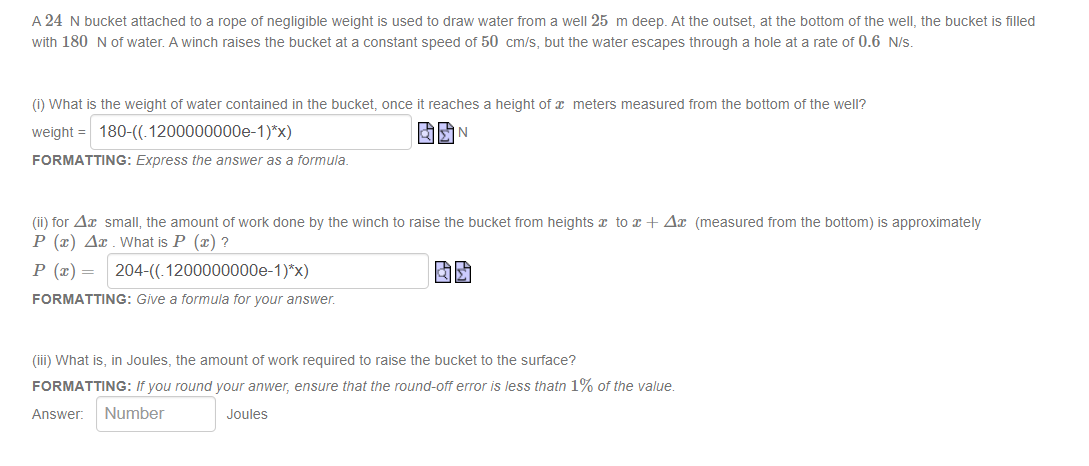(Solved): A 24N bucket attached to a rope of negligible weight is used to draw water from a well 25m deep. A ...
A
24Nbucket attached to a rope of negligible weight is used to draw water from a well
25mdeep. At the outset, at the bottom of the well, the bucket is filled with
180Nof water. A winch raises the bucket at a constant speed of
50c(m)/(s), but the water escapes through a hole at a rate of
0.6(N)/(s). (i) What is the weight of water contained in the bucket, once it reaches a height of
xmeters measured from the bottom of the well? weight
=논
NFORMATTING: Express the answer as a formula. (ii) for
\Delta xsmall, the amount of work done by the winch to raise the bucket from heights
xto
x+\Delta x(measured from the bottom) is approximately
P(x)\Delta x. What is
P(x)?
P(x)=
QFORMATTING: Give a formula for your answer. (iii) What is, in Joules, the amount of work required to raise the bucket to the surface? FORMATTING: If you round your anwer, ensure that the round-off error is less thatn
1%of the value. Answer: JoulesA 24 N bucket attached to a rope of negligible weight is used to draw water from a well 25 m deep. At the outset, at the bottom of the well, the bucket is filled with 180 N of water. A winch raises the bucket at a constant speed of 50 cm/s, but the water escapes through a hole at a rate of 0.6 N/s. (i) What is the weight of water contained in the bucket, once it reaches a height of x meters measured from the bottom of the well? weight = 180-((.1200000000e-1)*x) Preview Change entry mode N FORMATTING: Express the answer as a formula. (ii) for \Delta x small, the amount of work done by the winch to raise the bucket from heights x to x+\Delta x (measured from the bottom) is approximately P(x)\Delta x . What is P(x) ? P(x)= 204-((.1200000000e-1)*x) Preview Change entry mode FORMATTING: Give a formula for your answer. (iii) What is, in Joules, the amount of work required to raise the bucket to the surface? FORMATTING: If you round your anwer, ensure that the round-off error is less thatn 1% of the value. Answer: Number Joules
